From the mid-19th century, a succession of great female singers (divas) dominated opera. Their glamour and character, along with some of their most iconic performances, is captured in prints and photographs in the V&A collections.
Jenny Lind (1820 – 1887)
Around 1847, a lithograph was made of Jenny Lind, the great prima donna (leading lady), as she portrayed the character of Amina in the sleepwalking scene of Bellini's La Sonnambula (The Sleepwalker). The opera had a typical plot of the period: Amina is discovered in the bedroom of the Lord of the Manor. She is suspected of immorality and abandoned by her fiancé. The high point of the opera comes when, at night, she is spotted in her nightgown, candle in hand, walking across a dangerous bridge, revealing to everyone that she has been sleepwalking.
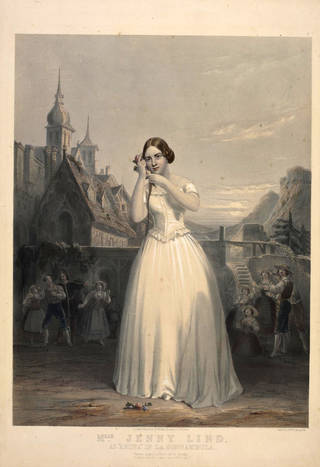
Lind made her London debut in 1847, but her extraordinary talents had become a talking point before this. In 1845, a correspondent of the Illustrated London News reported that, in Frankfurt, her performance as Amina prompted such large crowds, that backstage was filled with members of the audience who couldn't get seats in the auditorium. Her singing style was deceptively simple, but she was heralded a genius. At her debut performance in London, she had to encore one aria (solo song) twice and the conductor discarded his baton and applauded with the audience.
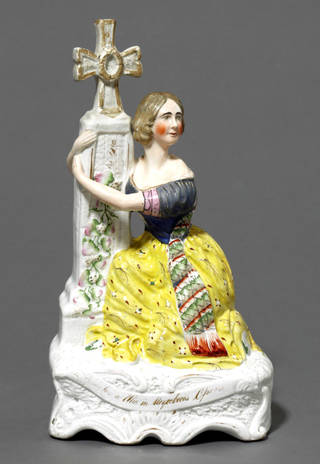
Adelina Patti (1843 – 1919)
For the Victorians, photography was a novel and exciting development. Most actors and actresses had studio photographs taken, in everyday dress or theatrical costume, for 'cartes de visite' and, later, 'cabinet cards', which were popular small photographs intended for trading among friends and family. A large collection of these, featuring the divas of the day, such as soprano, Adelina Patti, were bequeathed to the V&A by Guy Tristram Little, whose theatrical collection formed the basis of the Theatre Collections at the V&A.

Like many divas, Patti's singing earned her a fortune, which she flaunted. When she appeared in Verdi's La Traviata at Covent Garden, she had her jewellery dismantled, so that the diamonds, valued at around £200,000, could be sewn onto the bodice of her costume. Two policeman were borrowed from nearby Bow Street police station and mingled with the chorus on stage to keep an eye on them. The effect was dazzling.
Janet Baker
Janet Baker (b. 1933) is an English mezzo-soprano. Adulation is more commonly given to sopranos (the highest vocal range), for whom the most flamboyant roles are written. Baker is one of the few mezzo-sopranos (middle-range vocals) to inspire a similarly adoring public. During the 1970s she was one of the great operatic divas. She performed at the Royal Opera House, as well as singing with Glyndebourne Festival Opera, English National Opera and Scottish Opera. In the summer she gave recitals at the major British music festivals, such as York, Edinburgh, Aldeburgh and King’s Lynn. In 1982, at the height of her career, she retired.
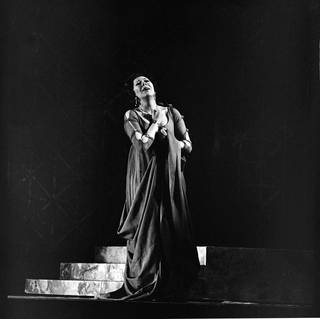
Janet Baker's performance in Mozart's opera, La Clemenza di Tito, at the Royal Opera House in 1974 caused a sensation. Her skills as an actress and singer were so complete, the critic, Stanley Sadie, wrote: "…verbal description falters before the power of Janet Baker…so impassioned is the acting, so noble and so delicate the singing".
Maria Callas (1923 – 1977)
Maria Anna Sophie Cecilia Kalogeropoulos, known to the world as Maria Callas, was one of the most famous soprano opera singers of the 20th century. She made her opera debut in Greece in 1941, but her breakthrough came in 1949 when she replaced another singer as Elvira in I Puritani in Venice. She married Giovanni Battista Meneghini, a wealthy Italian industrialist and opera lover, who became her manager and promoted her as the new star in Italian 'bel canto' (a stylized form of singing from Italy, popular in the 18th and 19th centuries, emphasising beauty of sound and technique).
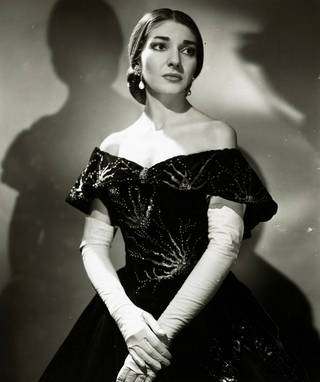
Callas was overweight at the start of her career, the ideal image of an opera singer at that time. In 1954 she suddenly lost weight and the promising singer became a glamorous, newsworthy, temperamental opera star. The media made less of her successful debuts in New York, London and Paris than her walk-outs from productions, quarrels with managements, firing from the Metropolitan Opera in New York and her affair with the Greek shipping magnate, Aristotle Onassis.
Her starring role in Tosca at the Royal Opera House in 1964 is remembered as one of the greatest opera experiences of all time. Although her voice wasn't always perfect, it was faultless in communicating raw emotion, passion and heart-stopping suspense.
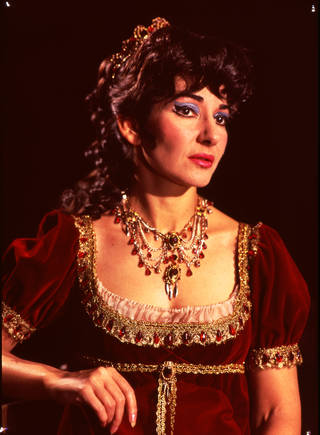
Joan Sutherland (1926 – 2010)
Joan Sutherland was one of the world's most famous soprano opera singers, particularly praised for her bel canto roles. She made her debut in Purcell's Dido and Aeneas in 1947 before coming to London to study at the Royal College of Music in 1951. In 1952 she was singing small roles at the Royal Opera House. Critics saw her career developing in the heavier operatic roles of Verdi or Wagner. It was her husband, conductor Richard Bonynge, who heard something rarer – a bel canto singer. Gradually he trained her voice upwards until it achieved complete flexibility in the upper register.
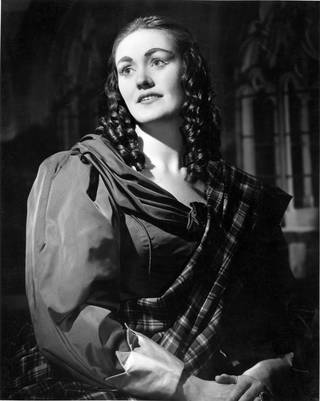
Sutherland's performance in the role of Lucia in Donizetti's Lucia di Lammermoor at the Royal Opera House in 1959 was a bel canto role that brought her instant stardom. The highlight of the performance was the scene in which Lucia, having been forced into an arranged marriage, murders her husband, loses her reason and dies. Sutherland had a hugely effective entrance, at the top of a long staircase in her bloodstained nightdress, pathetically conveying Lucia's helplessness and madness.
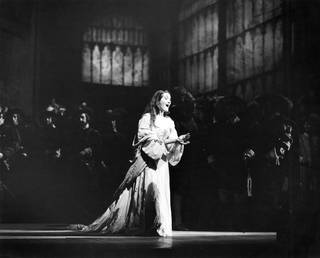
Sutherland's voice had a richness and brilliance unusual in coloratura sopranos (distinguished by being agile, fast-paced and with incredible vocal range). In comedy, she had an irrepressible sense of fun. Her warmth and complete lack of affectation endeared her to audiences worldwide.


